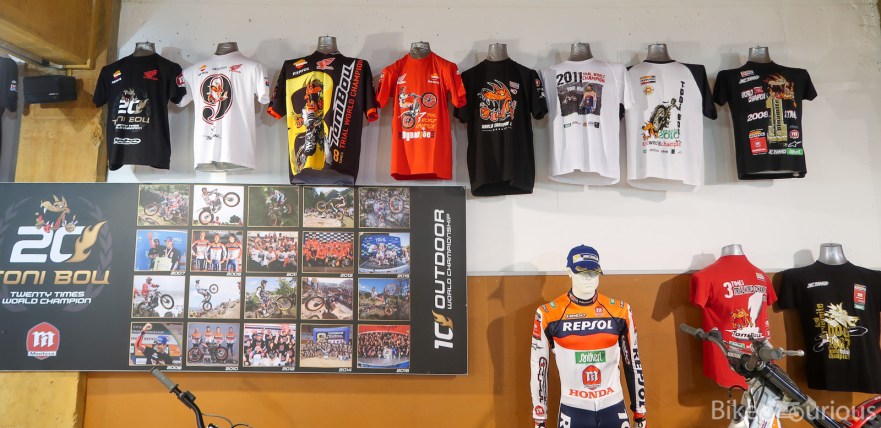Back when Vy and I were in Spain, we visited Museu Moto Bassella. It’s a tremendous place that took me hours to explore, so I figure in these times when COVID is keeping us at home I could let you take a mental trip about a hundred miles outside of Barcelona. Today, let’s focus on the off-roaders!
You can’t discuss Spanish off-roading without mentioning hometown hero Toni Bou – both the indoor and outdoor FIM Trial World Championship winner from 2007 to 2020! If you’ve never seen his skills before, here’s a fun little video of Toni playing “BIKE” (instead of “HORSE) with Antoine Buffart:
Back to the museum – there’s a section dedicated just to Toni himself!


Here’s where it all started, a Montesa bicycle that he switched away from at the age of 8 to begin trials with kids motorcycles like this Aprilia Climber 125.


The start of his incredible run – Toni’s 2007 indoor/outdoor championship winning Montesa Honda 4RT 260 (with his outfit for good measure).


2008 brought more of the same.


In 2016, Toni set a record for total World Titles – 20 of them at the time. He did it on this 4RT 260.

When you’re the best in the world, you can wear anything you want!

Speaking of which, Toni’s got a shirt for every title.


But Spanish off-roading history is more than just Toni’s recent trials dominance, and there are some other exhibits that are well worth learning more about. Going back in time, we’ve got this 1958 OSSA 175, a prototype off-roader based off a street bike that the Spanish firm entered into the International Six Days. OSSA created three, but none of them finished.

By 1963, the Spaniards had gotten into creating purpose-built off-roaders. This is a Bultaco Sherpa N with a 155cc engine, and it was the “first Spanish dual-purpose bike to be mass produced.”

That same year, Bultaco took a Sherpa S and modified it into this competition version for the ISDT. It earned Bultaco their first ISDT gold medals and would end up becoming the base of their first mass-produced dirt bikes.

Here we’ve got both a 1972 Montesa Cota 247 Mk3 paired with a 1971 Montesa Cota 25 – the latter was a 49cc children’s replica of the bigger bike built to get kids into the Montesa family as early as possible with something that made them proud because it looked like their dad’s bike.

The OSSA MAR (Mick Andrews Replica) was built after OSSA hired the English rider to design and ride a new trials bike – he went on to win two consecutive European Trials Championships and three consecutive Scottish Six Days Trials with it.

In 1973, Andrews moved to Yamaha, but OSSA kept producing this bike into the late 70s and it was highly competitive.

It weighs just 210 pounds and I think it’s one of the prettiest trials bikes ever built.

A motorcycle I had never heard of before was the 1973 Bultaco Biflecha. It was built to be a lighter, nimbler Matador however it proved to be unreliable and wasn’t successful in competition. Bultaco shelved it after building just eight examples, and the museum says this is the only one that remains.

This is the 1977 Montesa Enduro 250 K USA – just 600 were built, most of which were for the US. Differences from the Spanish model included a MPH speedometer, Lucas headlights, some chrome finishes…

…and a seat that you wouldn’t expect to see on an off-roader!

This 1978 Bultaco Frontera Mk11 was the race bike of Narcis Casas – as the museum puts it, “any work carried out on his official bike was always done with new year’s standard production bike in mind.”

There are also a few Dakar racers. This BMW G650X was scheduled to be campaigned in the 2008 Lisbon-Dakar, however that was cancelled due to terrorist threats so it instead competed in the Heroes Legend race. The rider was Pau Soler, a descendant of the museum’s founder, Mario Soler.


The following year, Pau was able to go to Dakar – this time he was on a BMW G450X as 2009 was the year that Dakar announced they’d be soon capping displacement at 450cc. He would go on to place 42nd.

But my favorite of the Dakar bikes was a bit older. Juan Porcar was Spain’s first Paris-Dakar motorcycle challenger, and he did it on a Spanish-built OSSA 350. The exhibit includes his clothes and sleeping bag, and it notes that he kept two pistons and a water bottle in his backpack.

Look where the 2-stroke oil was kept! Unfortunately for Juan, he ended up abandoning the race after he got lost for a couple of days, found a village with a well, and got sick after drinking from it without taking proper precautions.

Those are my highlights of the off-roaders, but Museu Moto Bassella is quite vast so I hope to share other sections of it with you soon. Did you catch my previous Picture Intermission dedicated to the signs and ads in this wonderful place?

